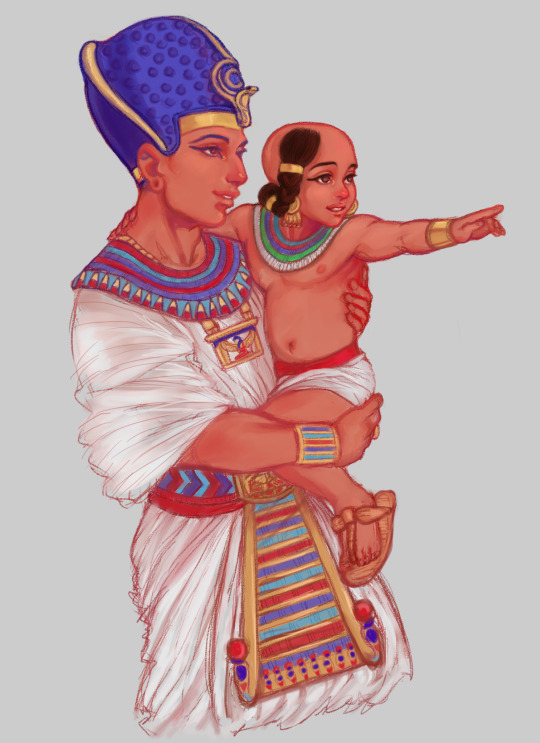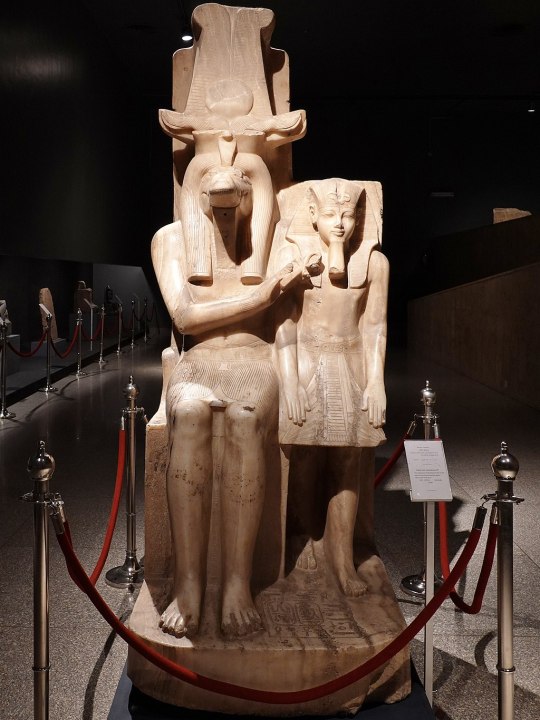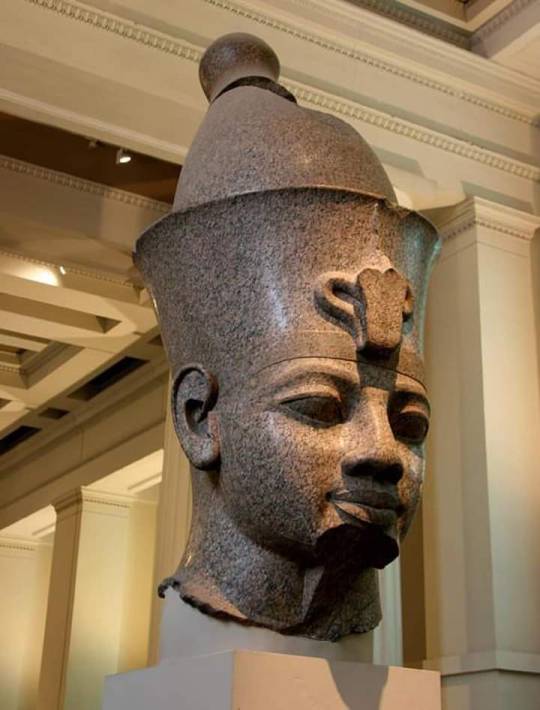#Amenhotep III
Text

Upper portion of a double seated granite statue of Amenhotep III & Ra-Horakhty discovered at the site of Amenhotep III's Mortuary Temple at the Theban Necropolis, 2010.
609 notes
·
View notes
Text

Ancient Egyptian faience amulet in the form of a cartouche of Nebmaatre, throne name of Amenhotep III "the Great" (r. ca. 1390-1352 BCE). Found in Amenhotep's tomb (WV 22) in the Valley of the Kings; now in the Metropolitan Museum of Art.
#art#art history#ancient art#Egypt#Ancient Egypt#Egyptian art#Ancient Egyptian art#18th Dynasty#New Kingdom#Amenhotep III#Nebmaatre#jewelry#jewellery#amulet#faience#cartouche#hieroglyphics#Metropolitan Museum of Art
555 notes
·
View notes
Text

They are looking at the freshly repainted Giza Sphinx idk
#old art from 2020#thutmose iv 🥺#baby amenhotep iii 💗#old.old art#imma try to do more art this yearrrrr#ancient egypt#thutmose iv#amenhotep iii#my art
449 notes
·
View notes
Text

Statue of Sobek and Amenhotep III, 1550-1292 BCE
322 notes
·
View notes
Text

Colossus of Memnon
Two giant statues of Amenhotep III, built in the 14th century BCE
Theban Necropolis, west bank of the Nile, Egypt
ca. 1920
#art#vintage#archaeology#sculpture#ancient#ancient art#ruins#ancient egypt#egyptology#amenhotep iii#ancient kemet#kemetic#kemet#egypt#egyptian art#kemetic art
133 notes
·
View notes
Text

The mummy of Queen Tiye, wife of Amenhotep III and mother of akhenaton .
📸 Unknown
226 notes
·
View notes
Text

Shadows
Raised, painted relief on the walls of Amenhotep iii’s Luxor Temple
#Luxor#temple#luxor temple#Thebes#Waset#egyptian#ancient egypt#ancient Egyptian#Egypt#egyptian temple#amenhotep iii#pharaoh#egyptian pharaoh#pharaohs#Kemet#Kemetic#kemeticism
23 notes
·
View notes
Text

Fragments of a queen's face (possibly Tiye), New Kingdom Egypt (18th dynasty, reign of Amenhotep III or Akhenaten; 1390-1336 BCE), yellow jasper
currently in the collection of the Metropolitan Museum of Art (New York City), accession no. 26.7.1396.
#archaeology#art#classical archaeology#egyptian archaeology#egyptology#egypt#new kingdom#amarna period#amenhotep iii#akhenaten
125 notes
·
View notes
Photo

Amenhotep III and his mother, Mutemwia, in a Kiosk — Nina de Garis Davies (1881–1965), 1914; original ca. 1390–1352 B.C.
162 notes
·
View notes
Text




the mummies of yuya and thuya. parents of queen tiye, and great-grandparents of tutankhamun.
Quibell, J. E.; Smith, Grafton Elliot (1908). Tomb of Yuaa and Thuiu. Le Caire Impremerie De L'Institut Francais D'Archeologie Orientale. pp.IV
#yuya#thuya#yuya and thuya#ancient egypt#mummies#akhenaten#tutankhamun#18th dynasty#queen tiye#amenhotep iii#nefertiti#the younger lady
72 notes
·
View notes
Text
Amenhotep III the Magnificent announced his marriage in a series of commemorative scarabs, the same shape as the well-known beetle amulets, which modern tourists have carried away from Egypt by the thousands, but large enough to contain a short inscription on the flattened base. This inscription read:
May he live, Amenhotep III, given life, and the King’s Great Wife Tiye, who lives. The name of her father is Yuya, the name of her mother is Thuya; she is the wife of a mighty king whose southern boundary is as far as Karoy, and northern as far as Naharin!
This announcement can be interpreted in a number of ways, but to me it sounds like a challenge. Tiye was not a king’s daughter. The tomb of her parents was found in 1905. It had been entered in ancient times, the coffins opened and some of the grave goods stolen. A lot was left, though, and the exposed mummies were in excellent condition. Tiye’s father, Yuya, was a fine-looking man; suggestions that was non-Egyptian, of Asiatic or Nubian origin, have no actual basis in fact. Yuya’s titles are not indicative of high rank. He is called “Master of the Horse,” and parts of a model chariot found in the tomb bear out this role. His wife had the usual titles of a court lady, in addition to being designated “Mother of the King’s Chief Wife.”
-Temples, Tombs, and Hieroglyphics by Barbara Mertz
#barbara mertz#amenhotep iii#scarabs#tiye#queen tiyi#yuya and thuya#ancient egypt#archaeology#temples tombs and hieroglyphs
18 notes
·
View notes
Text

Mummy of Amenhotep III
Originally buried in WV22 (Valley of the Kings), Amenhotep III's mummy was moved in ancient times to Tomb KV35, the tomb of Amenhotep II, which was used by Egyptian priests around the Third Intermediate Period as a royal "mummy" cache (storage). Tomb KV35 became a haven to protect the deceased, with priests placing royal mummies from throughout varied reigns together in one space to prevent more damage and theft from ancient tomb robberies.
Despite the rather poorly preserved condition of Amenhotep III's mummy (only his head is pictured here, but his mummified body does exist alongside his head), modern analysis of the king's remains tell us he died around aged 50, which matches Grafton Elliot Smith's estimation from over a century ago; that Amenhotep III's age at death was likely 40–50 years.
Amenhotep III now rests in the National Museum of Egyptian Civilization after being moved from the Egyptian Museum, Cairo, in April 2021.
Photo: Kenneth Garrett
Read more
177 notes
·
View notes
Text

Colossal granite head of Amenhotep III
From Egypt , now in the British Museum
7 notes
·
View notes
Photo

A 3400-Year-Old Painter’s Palette From Ancient Egypt,
Still Contains Traces of Pigment And Belonged To Pharaoh Amenhotep III.
This ancient artist’s palette is made from just one single piece of ivory. The palette has been so well preserved, it still contains remnants of pigments like green, blue, yellow, red, black, and brown.
This artifact is just one example of how the North African civilization of ancient Egypt was paving the way in the field of arts.
#art#design#palette#egypt#pharaoh#amenhotep iii#pigment#history#style#ivory#archeology#green#yellow#red#black#brown#africa
74 notes
·
View notes
Text



King Amenhotep III as a lion
Temple of Amun-Ra, Soleb (Nubia)
14th century BCE
British Museum
London, June 2022
#Amenhotep III#Egypt#Nubia#ancient#art#statue#lion#big cats#14th century BCE#king#pharaoh#British Museum#my photo
80 notes
·
View notes
Photo

Head of the Egyptian Pharaoh Amenhotep III, 18th Dynasty about 1400 BCE, Great Hall, British Museum, London, 2010.
#archaeology#egypt#pharaoh#amenhotep iii#great hall#british museum#london#england#united kingdom#2010#photographers on tumblr
104 notes
·
View notes